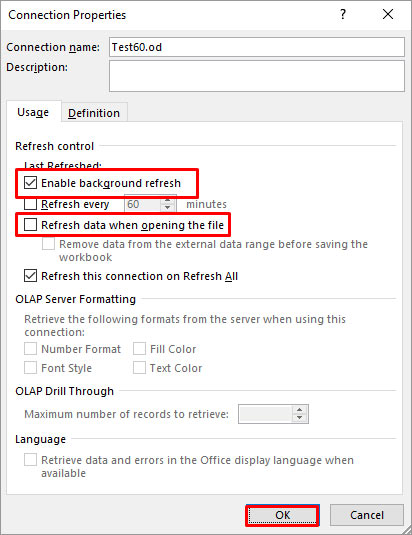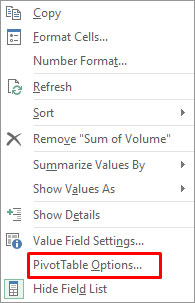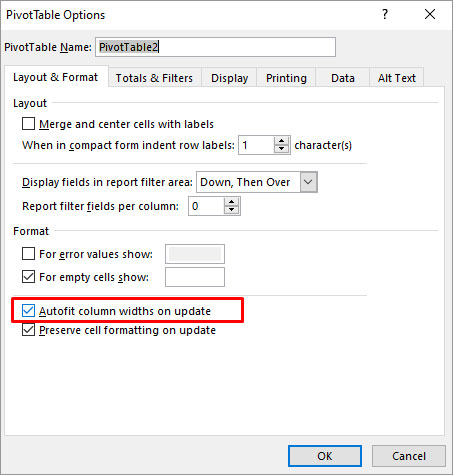
Solutions to Repair Corrupt Excel File 2010 | Stellar

Solutions to Repair Corrupt Excel File
Summary: MS Excel can throw various errors due to corrupted Excel files. This blog discusses the error messages that indicate Excel file corruption and the methods to prevent data loss due to a corrupt file. It also discusses the reasons behind the corruption in Excel file and their solutions. It also mentions a “Stellar repair for Excel” tool that can help to repair the corrupt or damaged Excel file.
Is your Excel file corrupted? And you don’t have backup of your data? There is no need to worry. There are some simple solutions to repair Excel file 2019. But before heading towards the solutions, let’s discuss the possible reasons for Excel file corruption and how you can prevent losing your data.
Error Messages that Indicate Excel File Corruption
When an Excel file gets corrupted, different error messages appear. For example:
- “Excel found unreadable content in
. Do you want to recover the content of this workbook, click Yes.” - “Can’t find project and library.”
- “The workbook cannot be opened or repaired by Microsoft Excel because it is corrupted.”
- “Microsoft Excel has stopped working.”
Reasons Behind Excel File Corruption
The reasons for corruption in Excel file could be any of the following:
- Improper system shutdown
- Computer virus/malware attack/Hacker attack
- Outdated anti-virus definition
- Hardware failure
- Unintentional deletion of files
- Large Excel files
- Bad sectors on storage media
How to Avoid Data Loss Due to Excel File Corruption?
Excel users should follow the below precautionary measures to prevent data loss due to Excel file corruption:
1. Create an Automatic Backup Copy
When you create an Excel spreadsheet, it is advised to Save As your document, as follows:
- In Save As window, click Tools next to Save option.
- Select General Options from the drop-down menu.
- Then check the dialogue box Always create back up and click OK.

This will always create a backup of your Excel. If it’s deleted or corrupted at any time, it can be recovered.
2. Create Recovery File at Different Time Periods
Steps are as follows:
- Go to File and then click Excel Options.
- Click Save and then select the Save Auto Recover information every checkbox
- Add the required minutes and location. Ensure that Disable AutoRecover for this workbook only box is unchecked.

Methods to Repair Corrupted Excel 2019 File
Try using these 5 methods to restore your Excel file and recover data:
Method 1: ‘Open and Repair’ Excel Files
Excel automatically opens the corrupted file in Recovery Mode. If not, you can repair Excel file manually through the following steps:
- Click on the File and select Open.

- Go to the location where the corrupt workbook is stored. In the Open window, select the corrupt file.
- Click Open and then select Open and Repair.
- In the window that opens, click Repair.
If the Repair option doesn’t work, you can select Extract Data and try to extract the values and formulae safely from the corrupt file.
Method 2: Recover Data from Open Workbook
If you face issues while working in an Excel file, you can choose to return to the last saved version of the Excel file. For this:
- Click File. Then select Open.
- Double click on the name of the workbook (the one that is open in your Excel).
- Click Yes to reopen it.

- The workbook will now appear.
Please note that it will show the last saved version and changes made after that won’t be recovered.
Method 3: Set Calculation Option as Manual
You can also recover data from Excel workbooks that you’re unable to open. For this, you need to configure the calculation option as manual in Excel. You can do this through the following steps:
- Click on File. Select New and open a Blank workbook.
- From File, select Excel Options.

- From the Formulas category, under the section Calculation options, select Manual. Now click OK.

- Then click File, and select Open to open the corrupted or damaged Excel file.
Method 4: Recover Content by Using External Links
You can also recover specifically the content (leaving formulas/calculated values) from the workbook by using external references (to link Excel workbook). For this:
- Click on File, Select Open.
- Navigate to the folder that contains the corrupted workbook.
- Now, right-click on the file name of the corrupted workbook and click Copy.
- Click File button. Then, select New and create another blank workbook.
- In the first cell (A1), type =!A1 and press Enter.
- Select the corrupted workbook in the Update Values dialogue (if it appears). Then click OK.
- Select the relevant sheet in the Select Sheet dialogue (if it appears). Then click OK.

- Again, select the cell A1, go to Home and select Copy.
- Now select (start from the cell A1) an area equal to that of the data in the original workbook.
- Go to Home now and select Paste.
- Again, go to Home, and Copy the data (the same selection of cells).
- Go to Home, and then click on the arrow below Paste. Then click on Values.
By pasting values, you removed the links to the corrupted workbook and only the data is left behind.
Method 5: Excel Repair Software
If the above-mentioned methods do not help in repairing the corrupt Excel file, try an Excel repair software.
One of the most commonly used Excel repair tools is Stellar Repair for Excel. Its trial version is available for free download, which lets you scan and preview the repaired Excel files. Once you’ve ascertained the effectiveness of the software, you can save the file after activating the software.
Here’s the complete repairing process of the corrupt Excel file
Conclusion
This post shared the reasons behind Excel file corruption and precautionary measures to prevent data loss. It also outlined different methods to repair corrupt Excel file 2019. There are several in-built utilities in Microsoft Excel to repair corrupt workbooks and recover data from it. In case these methods didn’t work, you can use Stellar Repair for Excel – an easy-to-use DIY tool that can fix all Excel corruption errors and restore data with all original properties.
How to fix “damage to the file was so extensive that repairs were not possible” Excel error?
Summary: Unable to resolve “damage to the file was so extensive that repair was not possible” error in Excel? Read this post to discover more details about the error, possible causes, and how to rectify the error. To save time & efforts, you can also try an Excel file repair software to resolve the “damage to the file…” error in a few clicks.
When opening a workbook in Microsoft Excel 2003 or later, you may encounter an error message,
“Damage to the file was so extensive that repairs were not possible. Excel attempted to recover your formulas and values, but some data may have been lost or corrupted.”

The error message may also occur while exporting an Excel file. Let’s find out what causes this error and what we can do to fix it.
Reasons Behind “Damage to the File Was So Extensive That Repairs Were Not Possible” Error
Your Excel file may be corrupt, oversized, virus-afflicted, etc., which can trigger this error and make the repair impossible. Below are some common reasons.
- Large or oversized excel files hindering export
- Data restore errors
- Field length of a cell is more than 256 characters
- Software conflicts, viruses, network failure
- Unable to open files in upgraded versions
- Errors on output exceeding 64000 rows
- Limited system resources (such as RAM, internal memory)
In a nutshell, the error generally happens if Excel discovers unreadable content, which may also interrupt file saving in Excel.
How to Resolve “Damage to the File Was So Extensive That Repairs Were Not Possible” Error?
Here are a few methods you can follow to fix or resolve the Excel repair error.
Method 1: Perform Basic Troubleshooting
When opening a corrupt workbook, Microsoft Excel automatically initiates the file recovery mode to repair the corrupt file. However, if it fails to perform automatic recovery, then follow these basic troubleshooting steps:
- This error mainly happens when you try to open the Excel file in an upgraded version. Try to open the file in an older version of Excel. You might be able to open it.
- Try saving the file with a different file name.
- Use a different file extension to save the file.
- You can save the Excel file as HTML and then open it. However, an HTML file might not save conditional formatting.
- Close other opened applications on the system which may be causing the error.
- Select less data for export at once.
- Delete worksheets if copied from another document; for instance, delete any file or screenshots you have imported.
- Open the file on another system.
If the error persists, then use the manual method to repair a workbook using the below steps:
- Go to the “File” tab.

- Select Open and select the damaged spreadsheet from the Recent Workbooks section on the right, if listed. However, if you cannot find the file in the Recent Workbooks section, click on “Browse” and choose the corrupted workbook.

- Click the drop-down arrow on the Open tab and select Open and Repair.

Method 2: Check if exporting a Heavy File is Causing Resource Limitations in Excel
Sometimes, when you try to export an Excel sheet carrying a huge database, you may face memory errors in older Excel versions like Excel 2003. Here, you’ll have to decrease the amount of data as Excel 2003 does not permit exporting extensive data beyond a limit. However, modern versions such as Excel 2007, 2010 & 2016 allow exporting a large amount of data and utilize more RAM than the older versions.
Following are some other workarounds:
- Use a lesser number of query presentation fields to re-generate the query. Then, again re-enter those fields.
- Decrease the multi-line string field data text up to 8000 characters.
Method 3: Copy Macros and Data to Another Workbook (Empty) in an Advanced Excel version
If the issue is occurring due to version incompatibility, i.e., if the file opens easily in the older version but shows errors in the new version. You can:
Use the older version to open the file or copy the data or macros in an empty workbook of the new version of Excel.
Copying the Macros in the Workstation
In Microsoft Excel, you can use the Visual Basic Editor to open the workbook with macro on another workbook by copying the macro. Both VBA tools and Macros appear in the Developer section of the excel file. This option is disabled by default. So first, you need to enable it.
Follow the instructions to enable it:
- Open Excel and go to File > Options.

- Click “**Customize Ribbon.**”

- Look at the right side of the pane and ensure the Developer tab is checked.

- Click OK.
Once you have enabled the Developer tab, follow the steps to copy the macro from one workbook to another:
- First, open both the workbooks- the workbook containing the macro and the workbook in which you need to copy the macros.
- Locate the Developer tab.

- Select Visual Basic to display the “Visual Basic Editor.”

- Go to the View menu in the Visual Basic Editor.

- Select Project Explorer.

- In the Project Explorer window, drag the module you need to copy to the destination workbook. For example:

Module 1 has been copied from Book2.xlsm to Book1.xlsm
Method 4- Restore the backup file
The workbook backup helps to open the corrupted or mistakenly deleted file. Sometimes, the issue can be fixed using the Recover Unsaved Workbook option in Excel. Here’s the list of steps to recover the files in Microsoft Excel:
- Go to the File tab on Excel.

- Click Open.

- Search on the top-left of the screen to click Recent Workbooks as below:

- Next, scroll down to the bottom.
- Click the “Recover unsaved workbooks” button.

- Scroll and find the lost file.
- Now double-click on the file to open.
Conclusion
“Damage to the file was so extensive that repairs were not possible” error can be fixed with the above troubleshooting methods or by using a third-party Excel repair tool, like Stellar Repair for Excel . Although There are no standard resolutions to fix the excel error as they may vary with different scenarios. In some cases, the manual methods might be time-consuming or fail to fix the error or recover the excel file. Hence, using an excel file repair tool may be the best option! It extracts data from the corrupted file and saves it to a new Excel workbook, which you can open and edit.
Ways to Fix Personal Macro Workbook not Opening Issue
Many users have reported encountering issues while accessing personal macro workbook, such as personal macro workbook not opening, personal macro workbook not loading automatically, Excel personal macro workbook keeps getting disabled, etc.
Such issues may arise due to a problem with the directory where the personal workbook is stored. However, there are various other reasons that may lead to such issues. Below, we’ll discuss the reasons behind the personal macro workbook not opening issue and the solutions to troubleshoot and fix the issue. But before proceeding, let’s understand why personal macro workbook is used.
Why Personal Macro Workbook is used?
You can access macros in a specific Excel workbook. However, when you need to use the same macro in other Excel worksheets, then you can create a personal macro workbook. A personal macro workbook (Personal.xlsb) is a hidden workbook that is used to store all macros. It makes your macros available every time you open Excel.
Causes of Personal Macro Workbook not Opening Issue
You may encounter personal macro workbook is not opening issue when attempting to record macros. Some possible causes behind such an issue are:
- Personal macro workbook is stored at an untrusted location
- Location of xlsb is changed
- Personal macro workbook is hidden
- Personal macro workbook becomes corrupted
- Disabled items in add-ins
- Workbook is Read-only
Methods to Fix the “Personal Macro Workbook not Opening” Issue
Follow the given methods to fix the personal macro workbook is not opening issue:
Method 1: Check the Path of Personal.xlsb
The personal macro workbook (Personal.xlsb) file is stored in XLStart folder. It opens automatically when you open your Excel application. However, sometimes it fails to load automatically. It usually occurs when you try to open the file from an incorrect path. You can check the path of Personal.xlsb by following these steps:
- Open the workbook.
- Click on the Developer tab.

- Press Alt + F11 to open Visual Basic Editor.
- Go to View > Immediate Window.
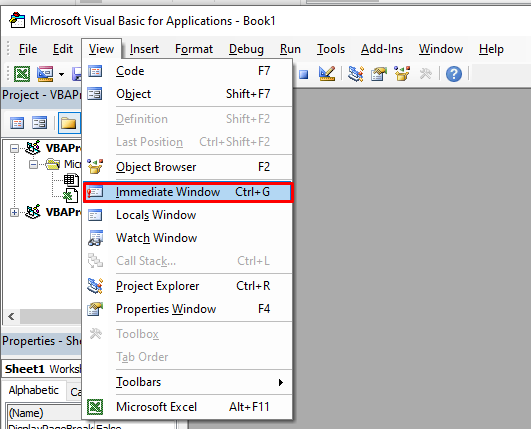
- In Immediate Window, type the following code to know the location of the workbook:
?thisworkbook.path.
- Then, hit Enter.
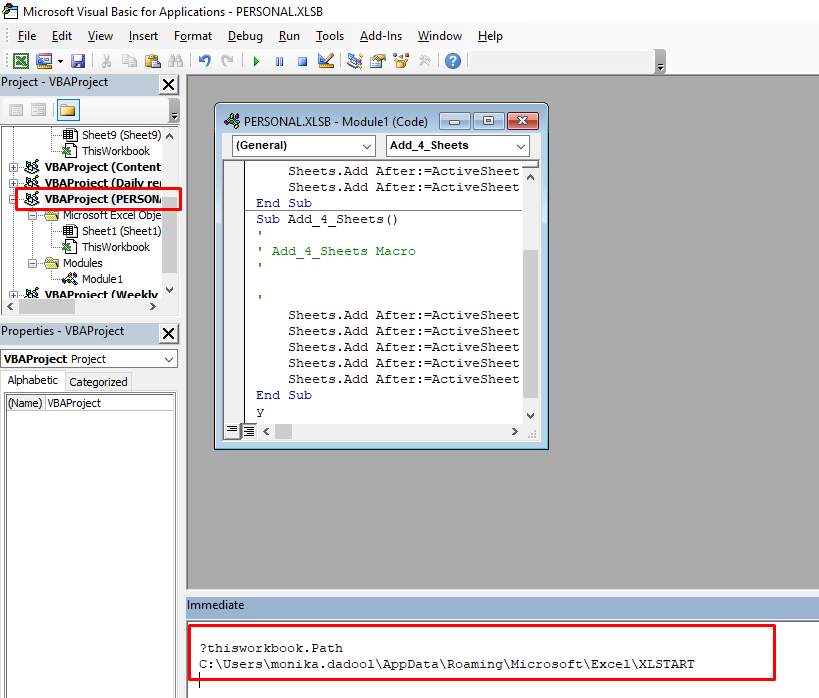
- You will see the path of the personal macro workbook.
- Copy the path and paste it into Quick Access field in File Explorer.

Method 2: Unhide Personal Macro Workbook
If personal macro workbook is hidden, you may unable to see and open the Personal.xlsb file. To unhide the personal Macro workbook, follow the below steps:
- In Microsoft Excel, go to View and then click Unhide

- The Unhide dialog box is displayed. Click PERSONAL and then OK.
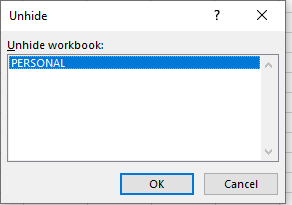
Method 3: Enable the Macro Add-ins
You may unable to open the previously recorded macros in your personal macro workbook if the macros are disabled. To check and enable the items, follow these steps:
- Go to File > Options.
- In Excel Options, click on the Add-ins
- Select Disabled Items from the Manage section and click on Go.
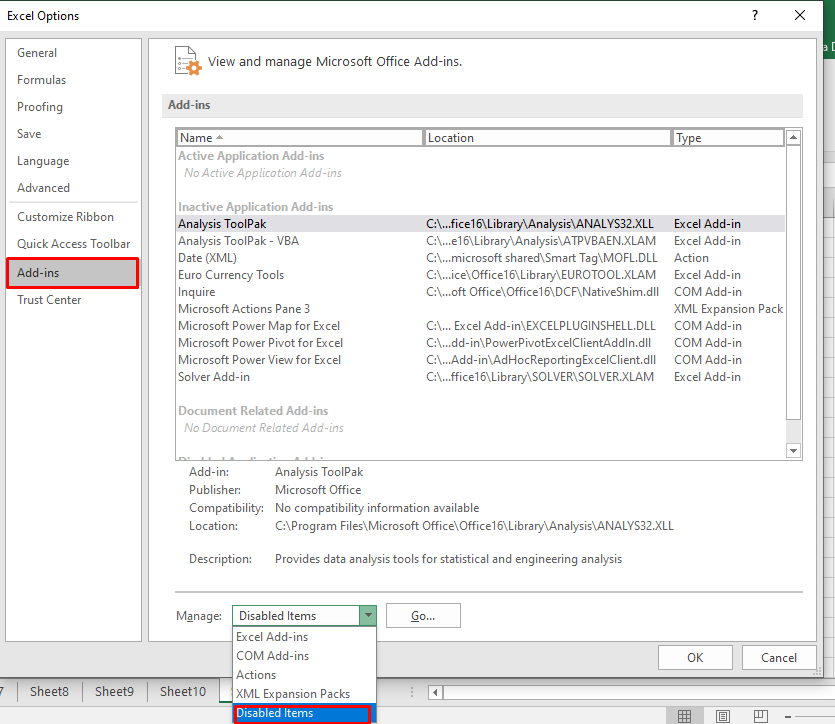
- The Disabled Items dialog box appears. Click on the disabled item and then click Enable.
Method 4: Change the Trusted Location
You may encounter the “personal macro workbook not opening” issue if the Personal.xlsb file is stored at an untrusted location. You can check and modify the path of XLSTART folder using the Trust Center window. Here are the steps:
- Open MS Excel. Go to File > Options.
- Click Trust Center > Trust Center Settings.
- In the Trust Center Settings dialog box, click on Trusted Locations.
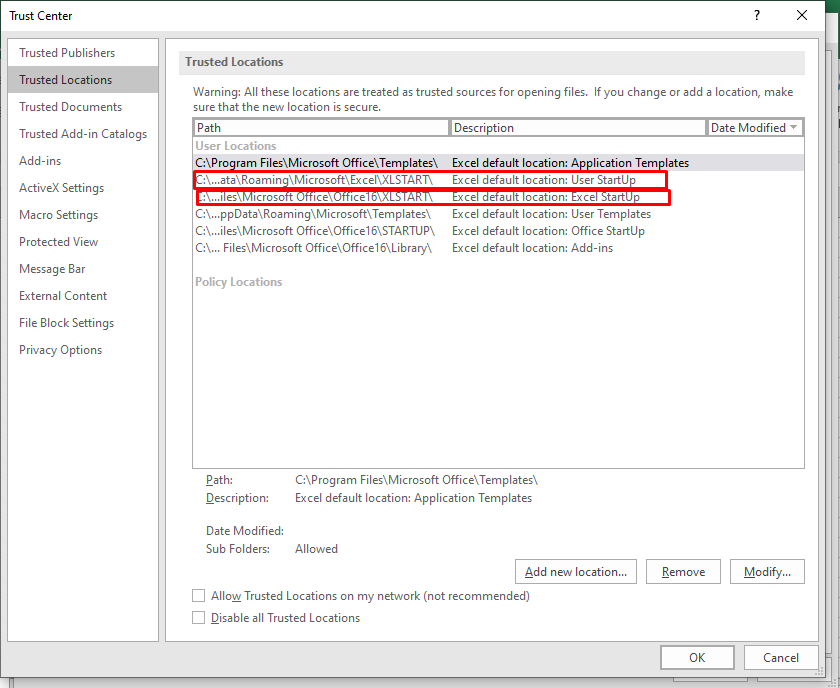
- Verify the path of the XLSTART If it is untrusted or there is any issue, then click Modify and then click OK.
Method 5: Repair your Excel File
You may fail to open personal macro workbook if it is corrupted. To repair the corrupt workbook, you can use the built-in Open and Repair utility in MS Excel. To use this tool, follow these steps:
- Open your Excel application.
- Click File > Open.

- Browse to the location where the corrupted file is stored.
- In the Open dialog box, select the corrupted workbook.
- From the Open dropdown list, click Open and Repair.
The dialog box appears with the Repair and Extract buttons. Click Repair to retrieve all possible data or the Extract option to recover the data without formulas and values.
If the Open and Repair utility fails to repair the corrupted Excel workbook, then you can use a professional Excel repair tool, such as Stellar Repair for Excel. It can easily repair severely corrupted Excel (XLSX and XLS) files and recover all the components. You can download the free trial version of the tool to preview the recoverable data.
Closure
This article discussed the ways to fix the personal macro workbook not opening issue. In case you are unable to open the personal macro workbook because of corruption in the workbook, you can use the Open and Repair utility in MS Excel. If it fails, then you can use Stellar Repair for Excel to fix corruption in the Excel file and recover all its data with complete integrity.
Filter Not Working Error in Excel [Fix 2024]
Summary: The filter is not working issue in Excel can occur due to several reasons, like blank rows, hidden rows, merged cells, corrupted data, etc. In this post, we will mention the reasons why the filter is not working correctly in Excel and several fixes to resolve the issue. We will also mention an advanced Excel repair tool to repair the Excel file if corruption in file is the cause of the issue.
You can use the Filter function in Excel to filter data in large-sized Excel files quickly. While using Excel filters, sometimes, you face a situation where the filter is disabled or may fail to function properly.

The Excel filter usually fails to work if you have not selected the complete and correct range of data. Let’s learn more about the “Sort and Filter not working in Excel” issue and look at the possible methods to fix it.
Why the Filter is not Working in Excel?
You can face the “filter is not working” issue if you are applying the filter on a protected worksheet or trying to find the data from a hidden row. Besides this, there could be many other reasons contributing to this issue, such as:
- The data you are trying to filter is in merged cells.
- The Excel file automatically selected the data up to the first empty cell, excluding the remaining rows.
- Grouped sheets in Excel file.
- Blank row in the Excel sheet.
- You are trying to apply a filter on an invalid data range.
- The workbooks in which you’re facing the filter issues are corrupted.
- You are specifying incorrect criteria in the filter columns.
Solutions to Resolve the Filter is not Working Issue in Excel
There might be two scenarios: the Excel filter option is disabled/grayed out or the filters fail to function properly. You can follow the given troubleshooting solutions to resolve the issue based on the scenario you’re facing.
Scenario 1 – Filter Option is Disabled or Grayed Out
Method 1: Check and Un-group the Worksheet
When you apply filters to a single sheet in a grouped set, Excel disables the filter option in other sheets within the group. You can check the grouped sheets and try ungrouping them to enable the filter option. Here’s how to do so:
- In the Excel file, go to the Group section.

- Right-click on the Ungroup Sheets.
Alternatively, you can press the Shift + Alt + Left keys to ungroup the sheets.
Method 2: Unprotect Worksheet
The “disabled Excel filter” issue can also occur if your worksheet is protected. You can unprotect the worksheet to enable the filter option. To do so, go to the Review tab and then select Unprotect Sheet.

Method 3: Check and Uninstall Excel Add-ins
Sometimes, the Excel filter gets disabled due to faulty or corrupted Excel add-ins. You can run the Excel in Safe mode to check whether the issue has occurred due to add-ins. To do this, type excel /safe in the Run window and click OK.

In safe mode, if you see the filter option, it indicates some problematic Excel add-ins were causing the issue. In such a case, you can check and uninstall the faulty Excel add-ins to fix the issue.
Scenario 2 – Filter is not Working
Method 1: Try Clearing Filters
Sometimes, the Excel filter fails to work correctly if some filters from the previous sessions are still active. In such a case, you can clear the applied filters. Follow the below steps:
- In Excel file, click Sort & Filter option.
- Select clear.

Method 2: Select Entire Data
The filter not working issue in Excel can occur when the range selected for filtering is incomplete or incorrect. You need to make sure that you’ve selected the entire data range in Excel. You can use the Ctrl+A keys to select the entire content in the worksheet.
Method 3: Check and Delete Blank Cells from the Table’s Columns
When you apply a filter to the data, Excel expects data to be in a continuous range. Excel filters do not consider the blank cells, thereby resulting in incorrect functioning of the filter. To resolve this issue, check and delete all blank cells. In case your Excel file is too large to delete the blank cells, then you can add a “Serial number” row as an alternative. Adding serial number row creates a data continuity, thus helping in fixing the filter-related issue.
Method 4: Unhide Hidden Rows and Columns
Hidden rows or columns in worksheets can also affect the filter functionality. You can check and unhide rows/columns to troubleshoot the issue. Here is how to do so:
- In the affected Excel file, go to Home.
- Click on Format > Hide & Unhide.

- Click Unhide Rows or Unhide Columns (as required).

Method 5: Unmerge Cells
You can experience the filter in Excel is not working issue if you are using the filter to extract data from merged cells. Ensure to unmerge the “merged cells” before applying a filter in Excel. Follow the below steps to unmerge the merged cells in Excel:
- Navigate to the Home option.
- In the toolbar, select the Merge & Center option.
- Click Unmerge Cells.
Method 6: Repair the Workbook
Sometimes, the Filter Not Working in Excel issue can occur due to inconsistencies in file structure. If these issues occurred due to corruption in the worksheet, you can repair it using the Open and Repair tool. It is an in-built tool in Excel that is used to repair corrupted Excel files. Here are the steps to use this tool:
- In the Excel application, navigate to the File option.
- Click Open and then click Browse to choose the Excel file.
- In the Open dialog box, click the problematic Excel file.
- Click the arrow next to the Open option and select Open and Repair.
- Click Repair to recover as much data as possible.
- The application prompts a message after the repair process is complete. Click Close.
In most cases, the Open and Repair tool can easily fix corruption issues in the Excel file. However, for any reason, if the open and repair tool doesn’t work you can consider repairing the file using a professional Excel Repair tool. Stellar Repair for Excel is one such advanced and secure tool to repair Excel files. With this tool’s powerful scanning capabilities, you can repair highly corrupted Excel files and recover all their objects with complete integrity. The tool is compatible with all Windows editions, including the latest Windows 11.
Closure
Several reasons are associated with the filter not working issue in Excel. The filter option may not work as expected if you have not selected the complete and correct range of data or for many other reasons. You can follow the troubleshooting methods discussed above to fix the issue. If the filter fails to work due to corruption in the workbook, then try Stellar Repair for Excel . It is an advanced tool that can even repair severely damaged files. It also helps to recover all the data from corrupted files without changing the original formatting. You can check the tool’s functionality by downloading its demo version. It allows you to preview all the repairable objects in the corrupted Excel file.
Quick Fixes to Repair Microsoft Excel 2013/2016 Content related error
Summary: The blog outlines some quick tips to fix ‘We found a problem with some content’ error in Microsoft Excel 2013/2016. It explains manual procedure to resolve the error and also suggests an automated tool to perform the repair process to retrieve all possible data from a corrupt workbook.
Sometimes, when opening an MS Excel file, you may receive an error message that reads:
“**We found a problem with some content in ‘filename.xlsx’. Do you want us to try to recover as much as we can? If you trust the source of this workbook, click Yes.**“

Figure 1 – Excel ‘found a problem with some content’ Error Message
What Causes ‘We Found a Problem with Some Content’ Error?
There is no clear answer as to what results in the Excel error – ‘**We found a problem with some content in <filename.xlsx>**’. However, based on some user experiences, it appears that the error occurs due to corruption in an Excel workbook. It may turn corrupt when:
- You try opening the Excel file saved on a network-shared drive.
- A string is added in a cell in Excel, instead of a numeric value.
- Text values in formulas exceed 255 characters.
How to Resolve ‘We Found a Problem with Some Content’ Error?
Follow these tips to fix the Excel error:
IMPORTANT! Before you follow the tips to resolve the Excel error, keep these points in mind: Make sure you have closed all of the opened Excel workbooks. Try restoring Excel file data from the most recent backup copy. If you don’t have a backup copy, make a copy of the corrupt Excel file and perform repair and recovery procedures on that backup copy.
Tip #1: Repair Corrupt Excel File
File Recovery mode is a native Excel recovery utility that automatically opens whenever any inconsistencies are found in the worksheet. If Microsoft doesn’t detect any issue or fails to open the File Recovery mode, you can start it manually to recover the corrupt Excel file. To do so, follow the steps below:
- Click on the File menu, and then select Open.
- In the Open dialog box, navigate to the folder location where the corrupt Excel file is saved.
- Select the corrupt file, and then click on arrow sign available next to Open button to select Open and Repair option.

Figure 2 – Open and Repair Feature in Excel
- Next, click Repair to recover maximum possible data.
- If the repair is not able to recover the data from the workbook, select Extract Data to extract all possible formulas and values from the workbook.
If repairing the corrupt Excel file doesn’t work, you can try an Excel file repair tool to fix corruption errors. You can also try to recover data from the corrupt file manually by following the next tips.
Read this: What to do when Open and Repair doesn’t work?
Tip #2: Set Calculation Option to Manual
To make the file accessible, try setting the calculation option in Excel from automatic to manual. As a result, the workbook will not be recalculated and may open in Excel. For this, perform the following:
- Click File, and then click New.
- Under New, click the Blank workbook option.
- When a blank workbook opens, click File > Options.
- Under the Formulas category, pick Manual in the Calculation options section, and then click OK.

Figure 3 – Select Manual in Calculation options
- Now, again click on the File menu and then click Open.
- Navigate to the corrupt workbook, and double-click it.
When the workbook opens, check if it contains all the data. If not, proceed to the next tip.
Tip #3: Copy Excel Workbook Contents to a New Workbook
Several users have reported that they were able to fix ‘We found a problem with some content in
- Open the Excel workbook in ‘read-only’ mode, and copy all its contents.
- Create a blank new workbook and paste the copied contents from the corrupt file to the new file.
Tip #4: Use External References to Link to the Damaged Workbook
Use external references to link to the corrupted workbook. By implementing this fix, data contents can be retrieved. However, it is not feasible to recover formulas or calculated values using this solution.
Follow the steps below:
- In Excel 2013/2016, click File > Open.
- Navigate to the folder where the corrupt file is saved.
- Right click the file, select Copy, and then click on Cancel.
- Again, click on File and then New.
- Under New option, click on Blank workbook.
- In the cell A1 of new workbook, type =File Name!A1 (where File Name indicates the name of the damaged workbook being copied in Step 3).
- If Update Values dialog box appears, click the corrupt workbook, and choose OK.
- If Select Sheet dialog box appears, click the appropriate sheet, and then click OK.
- Select cell A1.
- Next, click Home, and then click Copy (or, press Ctrl +C).
- Starting in cell A1, select area approximately the same size as that of the cell range that contains data in the damaged workbook.
- Next, click Home and select Paste (or click Ctrl + V).
- Keep the range of cells selected, click Home and then Copy.
- Finally, click on Home, click on the arrow associated with Paste and under Paste Values click on Values.
This will remove the link to the corrupt workbook and will retrieve data. But, keep in mind, the recovered data will no longer contain formulas or calculated values.
Alternative Solution – Stellar Repair for Excel
If the above manual methods fail to fix the ‘We found a problem with some content in Excel error’, try using the Stellar Repair for Excel software to resolve this error. The software helps repair and recover corrupt Excel files in just a few clicks. It can be used on a Windows 10/8/7/Vista/XP/NT machine to repair a corrupted workbook and recover every single bit of data from all the versions of the Excel workbook.
Read this: How to repair corrupt Excel file using Stellar Repair for Excel?
Conclusion
In this blog, we discussed some possible reasons behind Microsoft Excel 2013/2016 ‘We found a problem with some content’ error. The error may occur when an Excel file becomes corrupt. You may try repairing the corrupted Excel file manually by using the built-in ‘Open and Repair’ feature. Or, try the manual workarounds to extract data from the corrupt file discussed in this post. If the manual solutions don’t work for you, using Stellar Repair for Excel can come in handy in repairing the corrupt Excel (.xls/.xlsx) file and recovering the complete file data.
[Fixed] Excel PivotTable Overlap Error | Troubleshooting Guide
In Excel, you need to refresh the pivot table data source after adding new data. However, sometimes, while refreshing the pivot table, you may experience an error “PivotTable Report cannot Overlap.” This issue usually appears when there are multiple pivot tables in a single worksheet. It often occurs when you try to place one pivot table on top of another or if you try to set a common cell range to multiple pivot tables. However, there are many other causes associated with the error.
Reasons for a pivot table report cannot overlap another pivot table report issue:
- Merged cells in a pivot table may cause the overlap issue
- Using the same range of cells for multiple pivot tables
- Hidden columns
- Preserve formatting option is enabled
- Modifying the pivot table using a macro that is corrupted
- Using the workbook.RefreshAll method incorrectly
- Number of pivot items goes beyond the number of cells available
- Excel file is corrupt
- Corrupted Pivot table
- Some columns are labeled with the same name
Methods to Fix Excel PivotTable Report Cannot Overlap Error
You can get the pivot table overlapping issue if the field in pivot table crossed the maximum items limit. According to the Microsoft guide, you can specify up to 1,048,576 items to return per field. Check the cell fields in your pivot table. Also, make sure each column’s label is unique. Sometimes, the hidden columns or hidden sheets can also prevent you from modifying the pivot tables. You can check for hidden columns in the Data view.
If the error still persists, then try the below-mentioned methods to fix the error.
1. Move the Pivot Table to a New Worksheet
The “PivotTable Report cannot Overlap” error can occur if there is an issue with the columns in the pivot table. In this case, you can try moving the pivot table to a new worksheet. Moving the pivot table to a different worksheet automatically resets the column width according to the new sheet and creates space that can help in preventing the overlapping issue. Here are the steps to do so:
2. Disable the Background Refresh Option
When the background refresh option is enabled, then Excel updates the pivot table in the background after every minor change. It may create issue if you have a large-sized Excel file with multiple pivot tables. You can try disabling the background refresh option. Here’s how:
The Connection Properties dialog box is displayed. Unselect the “Enable background refresh” option and select the “Refresh data when opening the file”
Click **OK.

**
3. Disable Autofit Column Widths
When the Autofit column widths option is enabled, Excel automatically resizes the pivot table whenever you make changes to it. These automatic adjustments can sometimes add or remove fields which can result in the PivotTable Report cannot Overlap issue. To fix this, you can disable the “Autofit column widths on update” option. To do this, follow these steps:
Right-click on any field on the pivot table.
Select **PivotTable Options.

**
In the PivotTable Options window, unselect Autofit column widths on update.

Click on the OK.
4. Check the Workbook.RefreshAll Method
Several users have reported experiencing the “Excel PivotTable Report cannot Overlap” error when using the Workbook.RefreshAll method. This method is used to refresh data ranges in the pivot report. Sometimes, the error can occur due to missing variable that is representing an object (workbook) in a query. So, make sure you’re using the Workbook.RefreshAll function correctly.
5. Repair your Excel File
You may also encounter the “A PivotTable Report cannot Overlap” error if the Excel file is corrupted. You can use the inbuilt utility in Excel - Open and Repair to repair the corrupt file. Here’s how:
- In your Excel application, click on the File tab and then click Open.
- Click Browse to select the desired file.
- In the Open dialog box, click on the corrupted file.
- Click on the arrow next to the Open button and then click Open and Repair.
- Click on the Repair
- In the displayed message, click Close.
If the “Open and Repair” utility fails to fix the issue, then it means there is high level of corruption in the Excel file. To tackle this, you can take the help of a professional Excel file repair tool, such as Stellar Repair for Excel. The tool can easily repair severely corrupted Excel file and recover all the objects of the file, such as pivot tables, macros, charts, etc. with 100% integrity. You can download the free trial version of the tool to check its functionality.
Conclusion
In this article, we have discussed the possible reasons behind the “PivotTable Report cannot overlap” error in Excel. You can follow the methods mentioned above to fix the issue. The error may also occur if the Excel file gets corrupted. In this case, you can try repairing the corrupted Excel file using the Open and Repair utility or consider using Stellar Repair for Excel . The tool makes the process of repairing the Excel file smooth and quick.
[Fixed] Excel VBA Runtime Error 9: Subscript Out of Range
Summary: The runtime error 9 in Excel usually occurs when you use different objects in a code or the object you are trying to use is not defined. This post will discuss the reasons behind the Excel VBA error “Subscript out of Range” and the solutions to resolve the issue. It will also mention an Excel repair tool that can help fix the error if it occurs due to corruption in worksheet.
Many users have reported encountering the error “Subscript out of range” (runtime error 9) when using VBA code in Excel. The error often occurs when the object you are referring to in a code is not available, deleted, or not defined earlier. Sometimes, it occurs if you have declared an array in code but forgot to specify the DIM or ReDIM statement to define the length of array.
Causes of VBA Runtime Error 9: Subscript Out Of Range
The error ‘Subscript out of range’ in Excel can occur due to several reasons, such as:
- Object you are trying to use in the VBA code is not defined earlier or is deleted.
- Entered a wrong declaration syntax of the array.
- Wrong spelling of the variable name.
- Referenced a wrong array element.
- Entered incorrect name of the worksheet you are trying to refer.
- Worksheet you trying to call in the code is not available.
- Specified an invalid element.
- Not specified the number of elements in an array.
- Workbook in which you trying to use VBA is corrupted.
Methods to Fix Excel VBA Error ‘Subscript out of Range’
Following are some workarounds you can try to fix the runtime error 9 in Excel.
Method 1: Check the Name of Worksheet in the Code
Sometimes, Excel throws the runtime error 9: Subscript out of range if the name of the worksheet is not defined correctly in the code. For example – When trying to copy content from one Excel sheet (emp) to another sheet (emp2) via VBA code, you have mistakenly mentioned wrong name of the worksheet (see the below code).
1 | Private Sub CommandButton1_Click() |

When you run the above code, the Excel will throw the Subscript out of range error.
So, check the name of the worksheet and correct it. Here are the steps:
- Go to the Design tab in the Developer section.
- Double-click on the Command button.
- Check and modify the worksheet name (e.g. from “emp” to “emp2”).

- Now run the code.
- The content in ‘emp’ worksheet will be copied to ‘emp2’ (see below).

Method 2: Check the Range of the Array
The VBA error “Subscript out of range” also occurs if you have declared an array in a code but didn’t specify the number of elements. For example – If you have declared an array and forgot to declare the array variable with elements, you will get the error (see below):

To fix this, specify the array variable:
1 | Sub FillArray() |
Method 3: Change Macro Security Settings
The Runtime error 9: Subscript out of range can also occur if there is an issue with the macros or macros are disabled in the Macro Security Settings. In such a case, you can check and change the macro settings. Follow these steps:
- Open your Microsoft Excel.
- Navigate to File > Options > Trust Center.
- Under Trust Center, select Trust Center Settings.
- Click Macro Settings, select Enable all macros, and then click OK.

Method 4: Repair your Excel File
The name or format of the Excel file or name of the objects may get changed due to corruption in the file. When the objects are not identified in a VBA code, you may encounter the Subscript out of range error. You can use the Open and Repair utility in Excel to repair the corrupted file. To use this utility, follow these steps:
- In your MS Excel, click File > Open.
- Browse to the location where the affected file is stored.
- In the Open dialog box, select the corrupted workbook.
- In the Open dropdown, click on Open and Repair.
- You will see a prompt asking you to repair the file or extract data from it.
- Click on the Repair option to extract the data as much as possible. If Repair button fails, then click Extract button to recover data without formulas and values.
If the “Open and Repair” utility fails to repair the corrupted/damaged macro-enabled Excel file, then try an advanced Excel repair tool, such as Stellar Repair for Excel. It can easily repair severely corrupted Excel workbook and recover all the items, including macros, cell comments, table, charts, etc. with 100% integrity. The tool is compatible with all versions of Microsoft Excel.
Conclusion
You may experience the “Subscript out of range” error while using VBA in Excel. You can follow the workarounds discussed in this blog to fix the error. If the Excel file is corrupt, then you can use Stellar Repair for Excel to repair the file. It’s a powerful software that can help fix all the issues that occur due to corruption in the Excel file. It helps to recover all the data from the corrupt Excel files (.xls, .xlsx, .xltm, .xltx, and .xlsm) without changing the original formatting. The tool supports Excel 2021, 2019, 2016, and older versions.
Also read:
- [New] In 2024, Tips for Uploading Videos on Instagram
- [New] Tips for Transforming Twitter Videos Into Audio Songs (MP3)
- [Updated] Instant Photo Edit Focus Only Area Softening
- How to Mirror Apple iPhone 12 Pro Max to Roku? | Dr.fone
- How To Repair System Issues of Apple iPhone 15 Pro? | Dr.fone
- In 2024, The In-Depth Look at Nikon's 4K Powerhouse - J5
- In 2024, Top 10 Best Spy Watches For your Vivo V29 Pro | Dr.fone
- Remove the lock of Infinix Note 30
- Simple ways to get lost files back from Itel A05s
- Tiny but Mighty: In-Depth Review of Unihertz Atom XL's Performance
- Undelete lost photos from Poco M6 Pro 4G.
- Undeleted lost videos from OnePlus Ace 2V
- Title: Solutions to Repair Corrupt Excel File 2010 | Stellar
- Author: Ian
- Created at : 2025-01-20 21:02:30
- Updated at : 2025-01-21 18:30:51
- Link: https://techidaily.com/solutions-to-repair-corrupt-excel-file-2010-stellar-by-stellar-guide/
- License: This work is licensed under CC BY-NC-SA 4.0.


